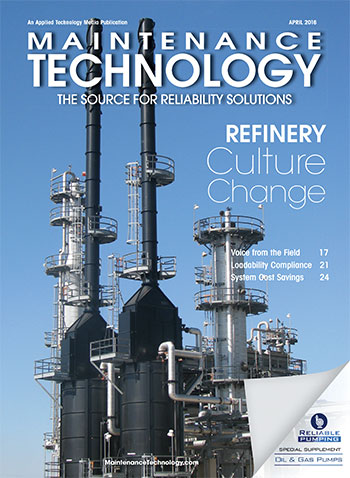Value-added opportunities to learn from the success of other industry pros don’t come along everyday. Grab them when you can, starting this June at the Mainstream Conference in Denver. Here’s what Joe Park of Novelis will be talking about.
By Jane Alexander, Managing Editor
Joe Park is a busy man. The Global Director of Reliability for Novelis, he spends considerable time helping drive excellence in maintenance and reliability efforts at his company’s sites around the world. As Maintenance Technology’s Sept. 2014 cover feature details, Park is good at his job. Moreover, he and Novelis are willing to share even more insight into these successful efforts with other busy maintenance and reliability professionals.
Park is among the featured speakers at this year’s information-packed Mainstream Conference, scheduled for June 7-10, in Denver, CO. His presentation, “Maintenance Psychology 101,” will address what he says are “some of the most overlooked and neglected components” when it comes to driving excellence in maintenance and reliability management. In the process, he’ll discuss approaches for dealing with a top challenge managers face across industry today: how to identify, grow and sustain competent maintenance and reliability teams.
According to Park, a hallmark of a successful, high-functioning, maintenance and reliability programs is the organization’s ability to implement work and activities via strongly defined hierarchies and closely aligned teams. But how does an organization get to that point? That’s where “psychology” comes in, Park says. It’s a key component managers often overlook and/or neglect in their maintenance and reliability efforts. He offers some quick tips:
“Hire first for attitude and aptitude,” Park advises. “Many maintenance managers make the mistake of valuing skill set above all else.” That strategy, evidently, can come back to bite them. “Hiring first for skill set without regard to attitude can lead to unhealthy dynamics within an organization,” Park warns. He says people with good attitudes and the aptitude to back them up will quickly learn the skills, and also be a more positive influence on their organizations.
Park also cautions maintenance and reliability managers against relying too heavily on a select few “experts” in their organizations. “That type of dependence can limit the overall knowledge base and capability of the organization,” he notes.
In Park’s opinion, getting the right people into the right jobs is paramount. After all, not everyone is suited for every task. “Understand the strengths, weaknesses and interests of people,” he says, “then align them with the proper roles for maximum effectiveness and job satisfaction.”
One goal of Park’s Mainstream Conference presentation is to help attendees ensure their maintenance and reliability programs have the right people in the right roles at the right time. Upon leaving his presentation, he says, attendees will have answers to the following questions:
- How do I select the right kind of people for different roles within an organization?
- What does a craft person value vs. what a maintenance manager should value?
- What motivates technical people?
- How do I identify and engage the natural leaders within the organization?
- How do I handle the naysayers and negative influences within an organization?
- As a manager, who is my target audience within the organization, i.e. who should I be spending time with?
- What traits do I look for when adding someone to the organization?
- How do I overcome the “electricians vs. mechanics” mentality to develop a functional maintenance team?
Park adds that too many maintenance and reliability managers still either spend too much time trying to convince naysayers on their teams to align or, conversely, too much time interacting with the positive team members to the exclusion of the “silent majority.” Neither approach makes the cut as an effective management strategy.
“The secret to turning organizations around,” Park stresses, “is for managers to embed themselves between the two extremes and win the hearts and minds of the people in the middle. Above all,” he says, “a manager must model the behavior and attitude he/she expects from the entire organization.”
Park will go into greater detail in his “Maintenance Psychology 101” presentation at the upcoming Mainstream Conference in Denver. To learn more about the event or to register, visit mainstreamconference.com/na.
Atop the Rocky Mountains, 2015 Mainstream Conference Will Be Digging Deep into Maintenance and Reliability
The Eventful Group’s Mainstream Conference is characterized as “an asset-management conference for companies that care about Leadership, People and Culture.” It’s also an interactive experience rather than a sit-and-listen event.
According to conference organizers, they continually meet with reliability, asset-management, maintenance and operations leaders to uncover their most critical challenges. In the past year, they claim to have spoken with more than 300 leaders and professionals from 150+ asset-intensive organizations. Recently, they conducted a full-day workshop with over 20 of the nation’s senior leaders in the space. Based on these conversations, they developed a list of 27 umbrella Hot Topics that reflect the pressing issues and areas of interest to the community in right now.
Solutions to these challenges will be in the spotlight at the 2015 Mainstream Conference June 7-10, in Denver, CO. The event features 40+ sessions, workshops, roundtables, panel discussions and interviews, along with a busy slate of networking opportunities and social gatherings. The entire schedule has been designed to help participants pinpoint new and different ways to increase reliability, reduce risk, embrace new technology and standards and unlock the true potential of their assets and people.
The 2015 Mainstream Conference will be held at the Westin Westminster Hotel, atop the Rocky Mountains between Denver and Boulder, CO. For complete details, visit mainstreamconference.com/na.






